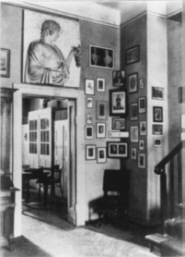The Institut für Sexualwissenschaft was an early private sexology research institute in Germany from 1919 to 1933. The name is variously translated as Institute of Sex Research, Institute for Sexology or Institute for the Science of Sexuality. The infamous Nazi book-burnings (Bücherverbrennung) in Berlin included the archives of the Institute.
The Institute was a non-profit foundation situated in the Tiergarten in Berlin's In den Zelten. It was headed by Jewish doctor Magnus Hirschfeld (1868-1935). Since 1897 he had run the Wissenschaftlich-humanitäres Komitee (Scientific-Humanitarian Committee), which campaigned on conservative and rational grounds for gay legal reform and tolerance. The Committee published the long-running journal Jahrbuch fur sexuelle Zwischenstufen. Hirschfeld was also a researcher; he collected questionnaires from 10,000 people, informing his book Die Homosexualität des Mannes und des Weibes (1914). He built a unique library on same-sex love and eroticism.
After the Nazis gained control of Germany in the 1930s, the institute and its libraries were destroyed as part of a government censorship program.
 Transgender pioneers
Transgender pioneersIn late February 1933, as the moderating influence of Ernst Röhm weakened, the Nazi Party launched its purge of homosexual (gay, lesbian, and bisexual; then known as homophile) clubs in Berlin, outlawed sex publications, and banned organised gay groups. As a consequence, many fled Germany (e.g. Erika Mann). In March 1933 the Institute's main administrator, Kurt Hiller, was sent to a concentration camp.
On 6th May 1933, while Hirschfeld was on a lecture-tour of the U.S., the Deutsche Studentenschaft made an organised attack on the Institute of Sex Research. A few days later the Institute's library and archives were publicly hauled out and burned in the streets of the Opernplatz. Around 20,000 books and journals, and 5,000 images, were destroyed. Also seized were the Institute's extensive lists of names & addresses. In the midst of the burning Joseph Goebbels gave a political speech to a crowd of around 40,000 people. The leaders of the Deutsche Studentenschaft also proclaimed their own Feuersprüche ('fire decrees against the un-German spirit'). Books by Jewish writers or with an anti-war theme (e.g. those by Erich Maria Remarque) from local public libraries and the Humboldt University were also burned.
There were many other small book-burnings organised around Germany on the same night; including at Munich's Konigplatz. By the 22nd May book-burnings had happened in Heidelberg, Frankfurt, Göttingen, Cologne, Hamburg, Dortmund, Halle, Nuremberg, Würzburg, Hannover, Münster, Königsberg, Koblenz, and Salzburg - and the Gestapo were confiscating public and private libraries to be destroyed in paper mills.
The buildings were later taken over by the Nazis for their own purposes. They were a bombed-out ruin by 1944, and were demolished sometime in the mid 1950s. Hirschfeld tried, in vain, to re-establish his Institute in Paris, but he died in France in 1935.
While many fled into exile, the radical activist Adolf Brand made a brave stand in Germany for five months after the book burnings. Finally the persecution became too much, and in November 1933 he was forced to announce the formal end of the organised homosexual emancipation movement in Germany. On June 28, 1934 Hitler conducted a murderous purge of gay men in the ranks of the S.A. wing of the Nazis, and this was followed by stricter laws on homosexuality and the round-up of homosexuals. It is hard to imagine that the address lists seized from the Institute did not aid Hitler in these actions. Many tens of thousands of arrestees found themselves, ultimately, in slave-labour or death camps. Others, such as John Henry Mackay, committed suicide.
One of the books known to have been burned on the Opernplatz was the works of the Jewish poet Heinrich Heine; one of his most famous lines is now: "Where they burn books, they will, in the end, burn human beings too" (1822).
Nazi era
The charter of the institute had specified that in the event of dissolution, any assets of the Dr. Magnus Hirschfeld Foundation (which had sponsored the Institute since 1924) are to be donated to the Humboldt University of Berlin. Hirschfeld also wrote a personal will while in exile in Paris, leaving any remaining assets to his students and heirs Karl Giese and Li Shiu Tong (Tao Li) for the continuation of his work. However, neither stipulation was carried out. The West German courts found that the foundation's dissolution and the seizure of property by the Nazis in 1934 was legal. The West German legislature also retained the Nazi amendments to anti-homosexual law §175a, making it impossible for surviving homosexuals to claim restitution for the destroyed cultural center.
Karl Giese committed suicide in 1938 when the Germans invaded Czechoslovakia and his heir, lawyer Karl Fein, was murdered in 1942 during deportation. Li Shiu Tong lived in Switzerland and the United States until 1956, but as far as is known, he did not attempt to continue Hirschfeld's work. Some remaining fragments of data from the library were later collected by W. Dorr Legg and ONE, Inc. in the U.S. in the 1950s.
After WWII
 Notes
NotesHistory of gays in Nazi Germany and the Holocaust Further reading
Rosa von Praunheim (Dir.) The Einstein of Sex (Germany, 2001). (About Magnus Hirschfeld - English subtitled version available).
No comments:
Post a Comment